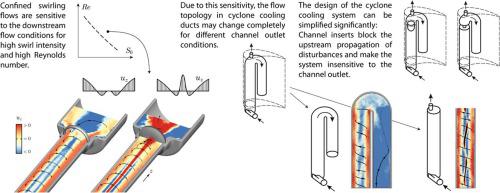当前位置:
X-MOL 学术
›
Int. J. Heat Fluid Flow
›
论文详情
Our official English website, www.x-mol.net, welcomes your feedback! (Note: you will need to create a separate account there.)
Considerations for the design of swirl chambers for the cyclone cooling of turbine blades and for other applications with high swirl intensity
International Journal of Heat and Fluid Flow ( IF 2.6 ) Pub Date : 2020-12-01 , DOI: 10.1016/j.ijheatfluidflow.2020.108670 Martin Bruschewski , Sven Grundmann , Heinz-Peter Schiffer
International Journal of Heat and Fluid Flow ( IF 2.6 ) Pub Date : 2020-12-01 , DOI: 10.1016/j.ijheatfluidflow.2020.108670 Martin Bruschewski , Sven Grundmann , Heinz-Peter Schiffer

|
Abstract The focus of this study lies on turbulent incompressible swirling flows with high swirl intensity. A systematic parameter study is conducted to examine the sensitivity of the mean velocity field in a swirl chamber to changes in the Reynolds number, swirl intensity and channel outlet geometry. The investigated parameter range reflects the typical kinematic flow conditions found in heat transfer applications, such as the cooling of the turbine blade known as cyclone cooling. These applications require a swirl intensity, which is typically much higher than necessary for vortex breakdown. The resulting flows are known as flow regime II and III. In comparison to flow regime I, which denotes a swirling flow without vortex breakdown, these flow regimes are characterized by a subcritical behavior. In this context, subcritical means that the flow is affected by the downstream channel section. Based on mean velocity field measurements in various swirl chamber configurations, it is shown that flow regime III is particularly sensitive to these effects. The channel outlet geometry becomes a determining parameter and, therefore, small changes at the outlet can produce entirely different flow patterns in the swirl chamber. In contrast, flow regime II, as well as flow regime I and axial channel flows, are much less sensitive to changes at the channel outlet. The knowledge about the sensitivity of the flow in different flow regimes is highly relevant for the design of a cyclone cooling system. Cooling systems employing flow regime III can result in a weakly robust flow system that may change completely over the operating range. As a remedy, the swirl intensity needs to be decreased so that flow regime III cannot be reached, which, however, reduces the maximum achievable heat transfer in the cooling system. Alternatively, the flow has to transition back from flow regime III to flow regime II or I before the flow leaves the swirl chamber. Two practical methods are presented. These findings can be directly applied in the design processes of future cyclone cooling systems, and other applications of swirling flow.
中文翻译:

用于涡轮叶片旋风冷却和其他高涡流强度应用的涡流室设计考虑因素
摘要 本研究的重点是具有高涡流强度的湍流不可压缩涡流。进行系统参数研究以检查涡流室中的平均速度场对雷诺数、涡流强度和通道出口几何形状变化的敏感性。研究的参数范围反映了传热应用中的典型运动流动条件,例如涡轮叶片的冷却,称为旋风冷却。这些应用需要涡流强度,通常远高于涡流击穿所需的强度。由此产生的流动称为流态 II 和 III。与表示没有涡流击穿的旋流的流态 I 相比,这些流态的特征在于亚临界行为。在这种情况下,亚临界意味着流动受下游通道截面的影响。根据各种涡流室配置中的平均速度场测量结果,表明流态 III 对这些影响特别敏感。通道出口几何形状成为一个决定性参数,因此出口处的微小变化会在涡流室中产生完全不同的流动模式。相比之下,流态 II 以及流态 I 和轴向通道流对通道出口处的变化不太敏感。关于不同流态下流动敏感性的知识与旋风冷却系统的设计高度相关。采用流态 III 的冷却系统会导致流动系统的鲁棒性较弱,可能会在整个操作范围内完全改变。作为补救措施,涡流强度需要降低,以便无法达到流态 III,然而,这会降低冷却系统中可实现的最大传热。或者,在流动离开涡流室之前,流动必须从流动状态 III 转换回流动状态 II 或 I。介绍了两种实用的方法。这些发现可以直接应用于未来旋风冷却系统的设计过程,以及旋流的其他应用。
更新日期:2020-12-01
中文翻译:

用于涡轮叶片旋风冷却和其他高涡流强度应用的涡流室设计考虑因素
摘要 本研究的重点是具有高涡流强度的湍流不可压缩涡流。进行系统参数研究以检查涡流室中的平均速度场对雷诺数、涡流强度和通道出口几何形状变化的敏感性。研究的参数范围反映了传热应用中的典型运动流动条件,例如涡轮叶片的冷却,称为旋风冷却。这些应用需要涡流强度,通常远高于涡流击穿所需的强度。由此产生的流动称为流态 II 和 III。与表示没有涡流击穿的旋流的流态 I 相比,这些流态的特征在于亚临界行为。在这种情况下,亚临界意味着流动受下游通道截面的影响。根据各种涡流室配置中的平均速度场测量结果,表明流态 III 对这些影响特别敏感。通道出口几何形状成为一个决定性参数,因此出口处的微小变化会在涡流室中产生完全不同的流动模式。相比之下,流态 II 以及流态 I 和轴向通道流对通道出口处的变化不太敏感。关于不同流态下流动敏感性的知识与旋风冷却系统的设计高度相关。采用流态 III 的冷却系统会导致流动系统的鲁棒性较弱,可能会在整个操作范围内完全改变。作为补救措施,涡流强度需要降低,以便无法达到流态 III,然而,这会降低冷却系统中可实现的最大传热。或者,在流动离开涡流室之前,流动必须从流动状态 III 转换回流动状态 II 或 I。介绍了两种实用的方法。这些发现可以直接应用于未来旋风冷却系统的设计过程,以及旋流的其他应用。



























 京公网安备 11010802027423号
京公网安备 11010802027423号